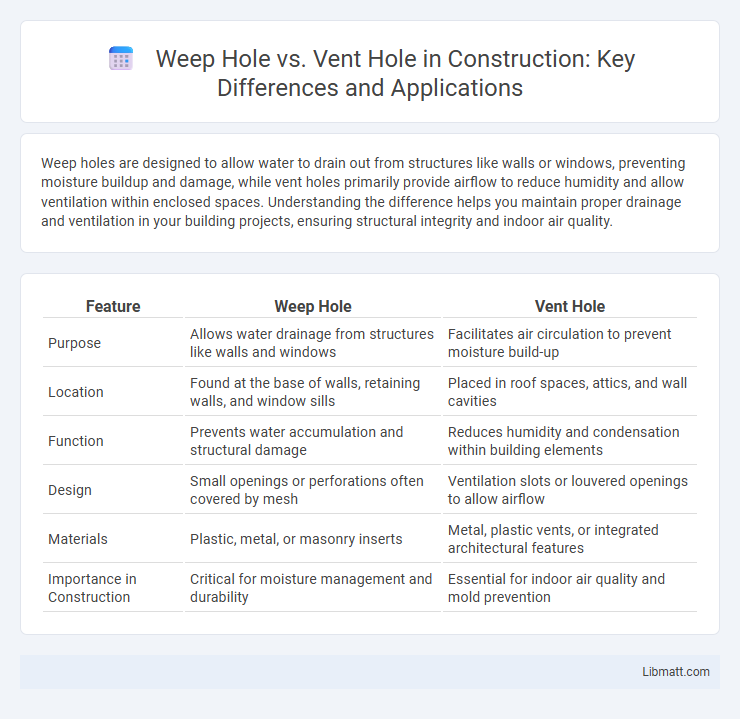Weep holes are designed to allow water to drain out from structures like walls or windows, preventing moisture buildup and damage, while vent holes primarily provide airflow to reduce humidity and allow ventilation within enclosed spaces. Understanding the difference helps you maintain proper drainage and ventilation in your building projects, ensuring structural integrity and indoor air quality.
Table of Comparison
| Feature | Weep Hole | Vent Hole |
|---|---|---|
| Purpose | Allows water drainage from structures like walls and windows | Facilitates air circulation to prevent moisture build-up |
| Location | Found at the base of walls, retaining walls, and window sills | Placed in roof spaces, attics, and wall cavities |
| Function | Prevents water accumulation and structural damage | Reduces humidity and condensation within building elements |
| Design | Small openings or perforations often covered by mesh | Ventilation slots or louvered openings to allow airflow |
| Materials | Plastic, metal, or masonry inserts | Metal, plastic vents, or integrated architectural features |
| Importance in Construction | Critical for moisture management and durability | Essential for indoor air quality and mold prevention |
Introduction to Weep Holes and Vent Holes
Weep holes and vent holes serve distinct functions in building construction and drainage systems. Weep holes primarily facilitate the escape of water trapped within walls or cavities, preventing moisture buildup and damage. Vent holes improve air circulation, reducing humidity and promoting the drying of enclosed spaces to maintain structural integrity.
Definition of Weep Holes
Weep holes are small openings strategically placed in walls, windows, or retaining walls to allow water to escape and prevent moisture accumulation that can cause structural damage. These drainage points facilitate the removal of trapped water behind masonry or cladding systems, enhancing durability and reducing the risk of mold growth. Unlike vent holes, which primarily provide air circulation, weep holes focus on effective water drainage to maintain the integrity of the construction.
Definition of Vent Holes
Vent holes are small openings designed to allow air circulation and moisture escape within a structure, preventing condensation and mold growth. Unlike weep holes, which primarily facilitate water drainage from walls or window frames, vent holes support ventilation to maintain dry, healthy environments. Properly installed vent holes contribute to building durability by reducing trapped moisture and improving air quality.
Key Differences Between Weep Holes and Vent Holes
Weep holes are designed to drain water from walls or window frames, preventing moisture buildup and structural damage, while vent holes primarily allow air circulation to reduce condensation and humidity. Weep holes are typically located at the lowest point of a structure to facilitate water egress, whereas vent holes are strategically positioned to optimize airflow. Understanding the key differences between these holes helps you maintain building integrity by addressing both moisture control and ventilation efficiently.
Functions and Purposes of Weep Holes
Weep holes serve as essential drainage points in walls or structures, allowing accumulated water to escape and preventing moisture buildup that can cause damage or mold growth. Their primary function is to maintain structural integrity by facilitating the removal of water trapped behind masonry or siding. Your building's longevity relies on properly placed weep holes to ensure effective water management and avoid costly repairs.
Functions and Purposes of Vent Holes
Vent holes serve the essential function of allowing air circulation within structures, preventing moisture buildup and pressure accumulation that could lead to damage. Their purpose is to maintain structural integrity by ensuring proper ventilation in walls, windows, or pipes, reducing the risk of mold, corrosion, and material deformation. You can optimize building longevity and indoor air quality by incorporating correctly designed vent holes.
Applications of Weep Holes in Construction
Weep holes are essential in construction for preventing water accumulation in masonry walls, retaining walls, and window sills by allowing trapped moisture to escape, thus reducing the risk of structural damage. These small openings facilitate drainage and air circulation, helping to maintain the integrity of the building envelope and prevent issues like mold and corrosion. Your building's durability significantly benefits from properly installed weep holes that ensure moisture management and prolong material lifespan.
Common Uses of Vent Holes Across Industries
Vent holes are primarily used in manufacturing, electronics, and construction industries to allow gases or air to escape, preventing pressure buildup and ensuring structural integrity. In electronics, vent holes help dissipate heat and prevent moisture accumulation within enclosures, enhancing device longevity. The automotive industry utilizes vent holes in fuel tanks and tires to maintain pressure balance and improve safety.
Importance of Proper Placement and Sizing
Proper placement and sizing of weep holes and vent holes are crucial for effective moisture management and ventilation in building structures. Weep holes must be positioned at the lowest points, such as the base of walls or window sills, to allow water to escape and prevent accumulation that can lead to mold or structural damage. Your construction or maintenance project benefits from correctly sized openings to ensure optimal airflow and drainage, reducing the risk of moisture-related issues and enhancing the longevity of the building materials.
Maintenance and Potential Issues
Weep holes require regular cleaning to prevent blockage from debris, which can cause water buildup and damage to structures. Vent holes help maintain airflow and reduce moisture accumulation, but if clogged, they may lead to poor ventilation and mold growth. Ensuring both weep holes and vent holes are clear is essential for your building's durability and moisture management.
Weep hole vs vent hole Infographic

 libmatt.com
libmatt.com